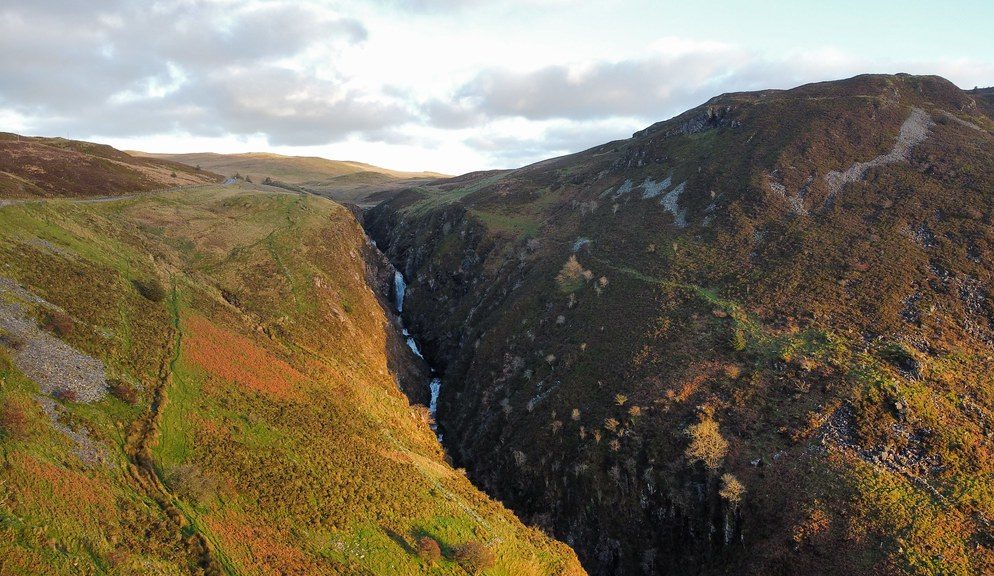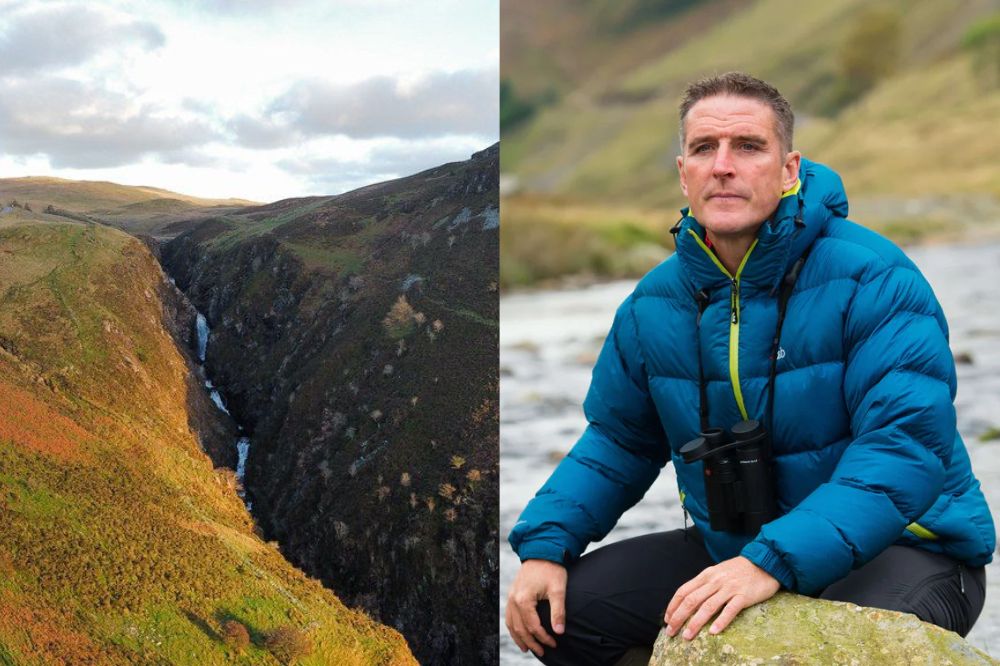Support grows for campaign to protect majestic Eryri waterfall

Stephen Price
More local people have spoken out in favour of protecting one of Eryri’s most scenic waterfalls which campaigners say is threatened by a hydro-electric scheme.
Plans have been submitted for a small scale hydro-electric scheme at Rhaeadr y Cwm near Llan Ffestiniog, which would see, at times, nearly 70% of its water diverted through a pipe around the waterfall.
The formal consultation period on the application closed at the end of September and over 1,000 individual objections were submitted by the members of the public.
Many did so through an e-action web page set up by the Snowdonia Society, Save our Rivers, the North Wales Wildlife Trust and Buglife. And over 500 of these objections were local, from North Wales.
Concerns
According to campaigners, the attitude of the Eryri National Park Authority towards the development has become clearer.
In a previous press release, Cymdeithas Eryri Snowdonia Society expressed concern that the developers had stated on their application form that they had received pre-application advice from the Authority that: “The principle of the scheme [is] considered acceptable.”
The National Park Authority has now made clear, however, in an email to the Society, that this is not the case.
Commenting on this, the award-winning journalist and author Dei Tomos, who in the past has been a member of the National Park Authority, commented: “It now appears that the hydro developers have not received any indication of support for their planning application from the Eryri National Park Authority.
“What they said on their application form was misleading and Cymdeithas Eryri has been assured that no indication of support has been given by the National Park’s Planning department.
“Of course we know that this is a controversial plan to say the least. Rhaeadr y Cwm and the Cynfal river gorge are exceptionally beautiful, one of the jewels in Eryri’s crown, not only in terms of the extremely impressive view, but also in its diversity of amazing plants and habitats.
“That has been recognised through its designation as a Site of Special Scientific Interest (SSSI) and an Area of Natural Beauty in the Eryri Local Plan. That means there is a responsibility not to ‘adversely affect [its] character or amenity’.
“But in addition this is an area of history and romance, and this unique valley with its amazing river gorge and waterfall is connected to the Mabinogion. It must be protected and preserved.”
Local Councillor speaks out
Another person who has spoken up for the waterfall is Cllr Marc Lloyd Griffiths, who happens to be the Chair of the Ffestiniog Town Council where the waterfall is located – though in this instance he is speaking as an individual.
He said: “Rhaeadr y Cwm is special in many ways. I hope that everyone understands that once the door has been opened, there will be no going back.”
The application is controversial as the gorge concerned is designated as an SSSI because of the very rare damp-loving plants which grow there, and because removing significant amounts of water risks changing the conditions that make it special.
Furthermore, campaigners say the amount of renewable electricity generated would be quite small. The capacity of the scheme would be just 600kW. In other words, it would take fully twelve schemes like this to generate the amount of electricity of just one modern wind turbine1.
Agreed in principle
But environmentalists, including Iolo Williams, are concerned that the scheme could nevertheless be approved, because of the previous belief that pre-application advice from the National Park Authority stated: “The principle of the scheme [is] considered acceptable.”

At the time, Iolo Williams said: “It is unbelievable that the planners of Eryri National Park have agreed, in principle, with this plan. Rhaeadr y Cwm has been designated as a Site of Special Scientific Interest due to the association of under-plants that grow in such a wet environment.
“A draw of nearly 70% of the water would have been extremely harmful to the rare ferns and mosses. I’m very supportive of social green energy but not when it means destroying the natural beauty of Wales.”
Inspiration
Plans have been submitted for a hydro-electric scheme in Cwm Cynfal three times over the past thirty years. Each of these times, they have been either refused or withdrawn. But in July the developers formally submitted another application.
Rory Francis, Director of Cymdeithas Eryri Snowdonia Society says: “Cwm Cynfal is a place that has inspired storytellers, artists and poets over a millennium.
“This is a landscape associated with the tales of the Mabinogion and also famously depicted by David Cox in 1836 in his iconic painting Rhaiadr Cwm.
“It is one of Eryri’s most majestic waterfalls. But now it is being threatened once again by a hydro-electric scheme that would see the river dammed and at times, just short of 70% of the water diverted out of the waterfall.”
Conservations stress that they are strongly support the need to decarbonise the economy. But with any renewable energy scheme, there is a need to weigh the damage against the benefits.
Excavating the river bed
One particular concern is that, unusually, the pipe through which the water would pass would cross underneath the river.
The developers plan to excavate the river bed, install the pipe, anchor it in concrete and then reinstate the river bed and banks.
Commenting on this, Dan Yates of Save our Rivers said: “This is not standard practice in normal hydropower construction. There are no specific details or working diagrams as to how this is to be achieved.
“There is significant risk of the pipeline being uncovered via erosion after construction or of the river diverting into the pipeline trench creating localised damage and sediment pollution of the water course and downstream SSSI.”
High profile support
The hydro scheme has, however, received support from high profile politicians.
Consultation at key stages has included Ffestiniog Town Council, which has confirmed its support, Cadw, Natural Resources Wales, Gwynedd Council, the National Park Authority, interest groups, and the public, who were invited to a drop-in event in February hosted by the brothers
Once in operation, the project, which has already had a water abstraction licence granted by NRW, will contribute towards the government’s goal of generating 70 per cent of energy needs from renewable sources by 2030.
Capable of producing up to 2million kWh per year, the scheme would supply 700 homes with electricity and potentially save almost 2,000 tonnes of CO2 emissions.

Dwyfor Meirionnydd MS Mabon ap Gwynfor and Dwyfor Meirionnydd MP Liz Saville Roberts have given their support to the development, which will help the brothers diversify their farming business.
Mabon ap Gwynfor said: “The climate emergency is the biggest challenge facing humanity and the target of achieving net zero by 2050 is fast approaching. It will be almost impossible to reach the target without schemes like this.
“Clearly there is great pressure on the agricultural industry to adapt to the challenge of climate change and this scheme is an example of a local agricultural family willing to meet the challenge and, as we fight against climate change, to play their part and contribute to the targets of the National Park as we strive to be carbon neutral.”
Liz Saville Roberts added: “The scheme is located in an environmentally sensitive area and it is therefore gratifying to know of all the work carried out by various experts in their field to document the nature of the site.
“The Authority has approved several hydro schemes in the area during the past twenty years and they have blended into the landscape of Eryri, with the majority of the public not even aware of their existence.”
The hydro scheme is proposing to be part of Energy Local, a community interest company (CIC) based in north Wales that aims to create more sustainable energy systems for communities across the UK.
Energy Local works by enabling communities to buy locally generated energy at a price fair to the generator and the consumers.
Plans
Plans show that a weir would be built across the river upstream of the waterfall, which will developers say will not affect the natural appearance of the falls.
The brothers said: “The plan is to help the country reach net zero, and to do that Wales needs a mix of different types of renewable energy.
“From evidence based information and correct mitigation, It’s important to us that the land and environment will not be adversely affected, and the specialists and experts commissioned have concluded that the scheme will have minimal effects on the location.
“We are passionate about the region in and around our farm and are determined to protect the river and the local ecosystem. We have taken every precaution, including a full environmental impact assessment, to ensure that there is minimal negative impact.”
Broad coalition
Dan Yates concluded: “The constant impact of development on our rivers and streams over the last few decades has led to the UK having one of the most degraded river systems in the world. It is critical that those remaining free-flowing sections of rivers that sit within protected areas, like the Cynfal, are preserved for future generations.”
Adrian Lloyd Jones, Head of Living Landscapes, North Wales Wildlife Trust said: “Considering the small amount of power this proposed HEP scheme would produce and the declines of bryophyte communities observed following similar HEP schemes elsewhere in north Wales, this scheme poses far too great a risk to the wildlife of Cwm Cynfal.
“Whilst we support green energy, all developments must be in the right place, and this proposal is clearly in the wrong place.”
Gemma Waters of Buglife agreed, sharing: “Unmodified fast flowing streams, such as Afon Cynfal, are one of the key habitats within the Eryri Important Invertebrate Area- which are nationally important sites for the conservation of invertebrates and the habitats upon which they rely.
“Abstraction, leading to changed flows, and barriers such as weirs, can create many adverse impacts on aquatic invertebrate communities but the scheme has not considered impacts on invertebrates.”
Nationally rare lichen
Meanwhile, as recently as this September this year Natural Resources Wales (NRW) revealed the discovery of the extremely rare lichen, Porina atlantica, in the Fairy Glen near Betws-y-coed.
This is only the second recording of the species anywhere in the UK. A recent survey of the site found 209 lichen species, with 94 classed as ‘nationally scarce’, almost doubling the number previously recorded.
Dan Yates added: “The Fairy Glen was previously threatened by hydro-electric development and this great news from NRW shows sites like this are special and no survey, no matter how well done, will record their full importance.
“Now the NGOs involved in protecting the Cwm Cynfal are asking for the same cautionary approach to hydro-electric development shown on the Conwy to be used at Cwn Cynfal”.
The application is likely to be determined by the National Park Authority’s Planning and Access Committee on 4 December or 22 January.
Support our Nation today
For the price of a cup of coffee a month you can help us create an independent, not-for-profit, national news service for the people of Wales, by the people of Wales.




